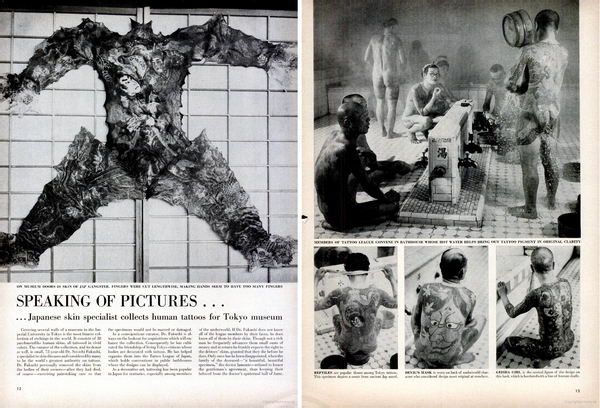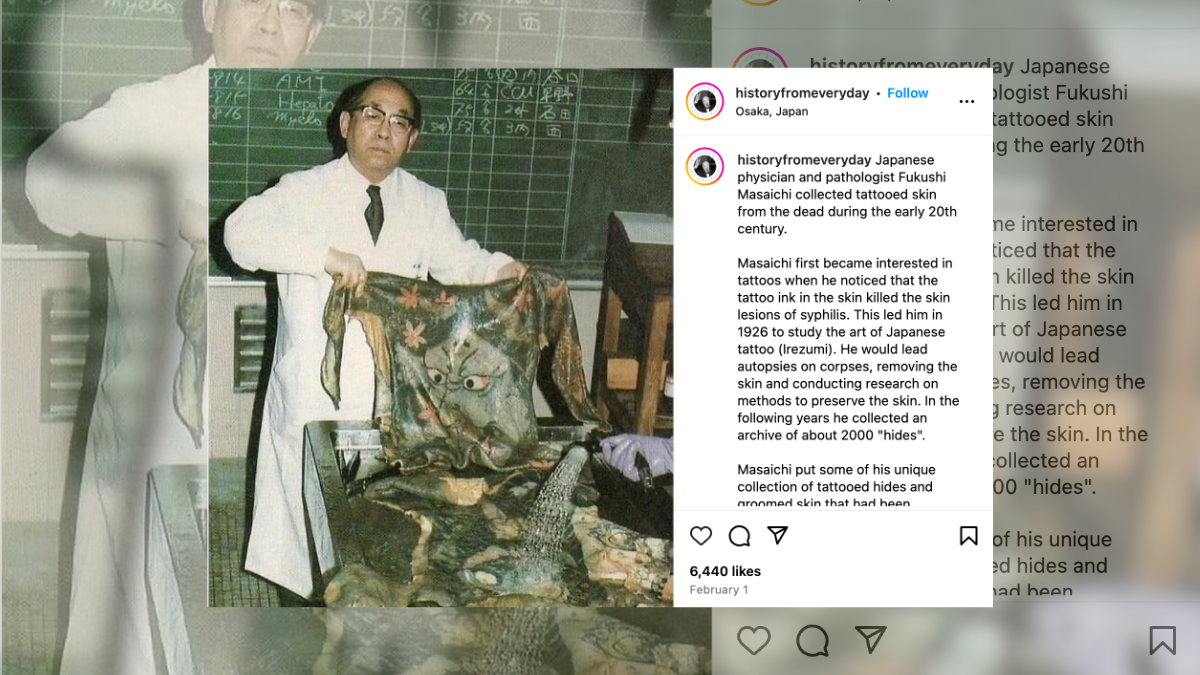Images of what appears to be leathery, draped human skin covered in ornate and oftentimes colorful tattoos have circulated the internet claiming to show Japanese physician and pathologist Dr. Fukushi Masaichi who, as part of his research, "collected tattooed skin from the dead during the early 20th century."
Different versions of his supposed life and research have circled corners of the internet, including claims that his research focused on the study of skin pigmentation, or that his collection contained at least "105 tattooed body suits." While Snopes wasn't able to independently verify all of these claims, most of which have reappeared on various websites without proper citation or linking to official sources, we did confirm that he was a real doctor.
For these reasons, we have rated this claim as "Research in Progress" while we await further responses from experts.
Snopes contacted the University of Tokyo Archives in Japan, which confirmed that Masaichi graduated from the University of Tokyo, then the Tokyo Imperial University College of Medicine, in July 1907.
The material about Masaichi in the archives is an album published in March 1927. At the time, Masaichi was a lecturer at the Faculty of Medicine where he was "in charge of pathology and anatomy," the archives told Snopes in an email. In this album, for example, Masaichi's photo can be seen on the 29th image with his signature on the 28th image written as it appeared below:
福士政一.
At our request for further information into Fukushi's Masaichi research, specifically his focus on tattooed human skin, Snopes was referred to the university's Medical Library. We will update this article should more information be provided.
Further investigation led our newsroom to the April 3, 1950, issue of LIFE magazine, which featured an article about "Dr. Sei-ichi Fukushi" titled, "Speaking of Pictures … Japanese skin specialist collects human tattoos for Tokyo museum." Page 12 of the article read:
Covering several walls of a museum in the Imperial University in Tokyo is the most bizarre collection of etchings in the world. It consists of 38 parchmentlike human skins, all tattooed in vivid colors. The curator of the collection, and its donor as well, is small, 72-year-old Dr. Sei-ichi Fukushi, a specialist in skin disease and considered by many to be the world's greatest authority on tattoos. Dr. Fukushi personally removed the skins from the bodies of their owners – after they had died, of course – exercising painstaking care so that the specimens would not be marred or damaged.
As a conscientious curator, Dr. Fukushi is always on the lookout for acquisitions which enhance the collection. Consequently, he has cultivated the friendship of living Tokyo citizens whose bodies are decorated with tattoos. He has helped organize them in the Tattoo League of Japan, which holds conventions in public bathhouses where the designs can be displayed.
As a decorative art, tattooing has been popular in Japan for centuries, especially among members of the underworld. If Dr. Fukushi does not know all of the league members by their faces, he does know all of them by their skins. Though not a rich man he frequently advances them small sums of money and in return he frankly expects the right to the debtors' skins, granted that they die before he does. Only once has he been disappointed, when the family of the deceased – "a beautiful, beautiful specimen," the doctor laments – refused to honor the gentleman's agreement, thus keeping their beloved from the doctor's epidermal hall of fame.
It is unclear why there is a discrepancy in the names "Sei-chi" and "Masaichi," such as whether this was a misspelling or if the two names represented different people.
 (LIFE Magazine/Public Domain)
(LIFE Magazine/Public Domain)
Fukushi Masaichi was also mentioned on page 80 of the 2005 book, "Tattoos, Desire and Violence: Marks of Resistance in Literature, Film and Television." It described a fictional character in the book, "The Tattoo Murder Case," originally published in Japan in 1948 under the title, "Shisei Satsujin," as being "most likely based on Dr. Masaichi Fukushi." The text continued:
… a doctor of medicine specializing in pathology who began a collection of tattooed skin at the Medical Pathology Museum of Tokyo University: "he began to study the and catalog motifs and designs of more than two thousand people, and collected over three thousand photographs of the work..."
Snopes found a reference to him in the 1991 article titled, "Tattoos and Tattooing Part 1 History and Methodology" published in The American Journal of Forensic Medicine and Pathology. We have contacted the journal for access to the article and will update this article with the information available.
Our newsroom also found mention of him and his reported son, Katsunari, in the 1998 book, "Modern Mummies: The Preservation of the Human Body in the Twentieth Century," written by Christine Quigley, on at least four pages. We've contacted the author for further information about their lives.
If you have further information about Masaichi's work, or access to either of the above publications, please contact our newsroom. (You can always submit other suspicious online content through this portal and our editorial team will do their best to look into your claim.)
As Snopes reported in 2021, "Tattoos become permanent by piercing the top layer of the skin and depositing a small amount of ink within each puncture."

